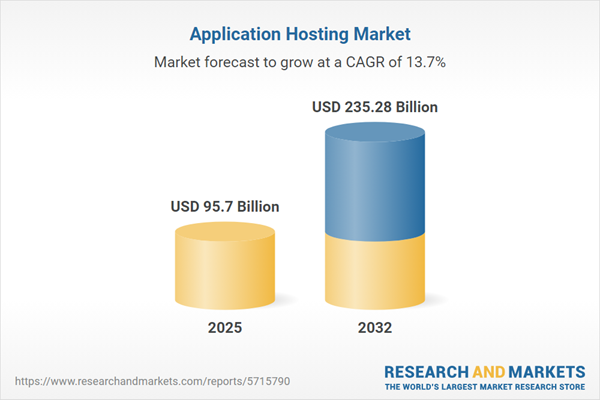Speak directly to the analyst to clarify any post sales queries you may have.
The application hosting market is rapidly evolving as enterprises pivot to more flexible, secure, and scalable hosting solutions that match their digital transformation goals. This shift is reshaping both operational models and competitive strategies in a landscape defined by technological innovation and increased regulatory scrutiny.
Market Snapshot: Application Hosting Market Growth, Drivers, and Outlook
The application hosting market grew from USD 84.13 billion in 2024 to USD 95.70 billion in 2025, with an expected CAGR of 13.71% through 2032, reaching USD 235.28 billion. This expansion is driven by accelerated digital transformation, increasing demand for scalable IT infrastructure, and the widespread adoption of cloud-native technologies. Regulatory developments, such as new tariff policies and evolving data protection standards, are also shaping business decisions and supply chain strategies. Enterprises worldwide are moving away from traditional hosting models, repositioning their strategies to address resilience, compliance, and performance in an interconnected digital economy.
Scope & Segmentation: Comprehensive Coverage of Application Hosting Solutions
This report provides a detailed analysis of the application hosting market, segmented by service model, deployment strategies, industry verticals, organization size, application types, and pricing approaches. Key segment highlights include:
- Service Models: Infrastructure as a Service, Platform as a Service, and Software as a Service offerings, each providing distinct value to organizations with varied digital maturity.
- Deployment Models: Community cloud, hybrid cloud, private cloud, and public cloud architectures, supporting different security, compliance, and scalability requirements.
- End-User Industries: BFSI, energy and utilities, government and defense, healthcare, IT and telecom, manufacturing, media and entertainment, and retail and e-commerce, addressing industry-specific compliance and integration needs.
- Organization Sizes: Large enterprises and small & medium enterprises, reflecting unique challenges in scale, complexity, and support requirements.
- Application Types: Dedicated and shared hosting, development and testing, e-commerce hosting, enterprise hosting, managed hosting, and web hosting, catering to different performance and service level considerations.
- Pricing Models: Freemium, pay-as-you-go, and subscription-based models, enabling organizations to align costs with usage and project cycles.
- Regions Covered: Americas (including North America and Latin America), Europe, Middle East & Africa, and Asia-Pacific—capturing diverse regulatory, cultural, and technological influences.
- Key Companies Analyzed: Amazon Web Services, Microsoft Corporation, Google LLC, Alibaba Group Holding Limited, International Business Machines Corporation, Oracle Corporation, Tencent Holdings, Huawei Technologies, Salesforce, and SAP SE.
Key Takeaways for Senior Decision-Makers
- Cloud-native approaches and container orchestration are redefining deployment agility and accelerating application development cycles across industries.
- Hybrid and multi-cloud strategies empower organizations to optimize workloads for compliance, cost, and localized service delivery.
- Regulatory pressures, such as data sovereignty and evolving tariffs, encourage investment in governance and risk mitigation frameworks for global hosting operations.
- Advanced technologies—including AI, machine learning, and edge computing—are increasing automation, resource optimization, and enabling real-time analytics for mission-critical workloads.
- Leading providers are focusing on building developer ecosystems, integrating open-source projects, and enhancing security to deliver differentiated services and ensure sustained performance.
- Shifts to flexible pricing and managed services make it easier for both large and mid-sized organizations to access scalable, robust hosting solutions that support digital innovation.
Tariff Impact: Navigating Cost Structure Volatility in a Shifting Global Economy
Recent United States tariff policies have had cascading effects on global supply chains, particularly impacting hardware procurement and component pricing for hosting infrastructure. Enterprises are responding by accelerating virtualization and containerization initiatives while diversifying supplier relationships. Emphasizing software-defined models and domestic partnerships, organizations are enhancing the resilience of their hosting environments to withstand tariff-induced volatility and regulatory change.
Methodology & Data Sources
This report integrates primary research, including comprehensive interviews with C-level executives and industry experts, with secondary research from white papers, regulatory guidelines, and public filings. Qualitative analysis and benchmarking ensure robust, actionable insights tailored for the application hosting market.
Why This Report Matters for Enterprise Strategy
- Enables decision-makers to benchmark current hosting strategies against global best practices and identify critical areas for improvement.
- Offers actionable guidance to future-proof infrastructure investments in response to new regulations, evolving technology stacks, and disruptive market shifts.
- Supports risk mitigation efforts by outlining key governance considerations and supplier diversification opportunities.
Conclusion
Successfully navigating the evolving application hosting ecosystem requires leaders to harness innovation, prioritize robust governance, and align hosting strategies with both business objectives and emerging regulatory frameworks. This report provides the strategic clarity needed for sustained success in this dynamic environment.
Additional Product Information:
- Purchase of this report includes 1 year online access with quarterly updates.
- This report can be updated on request. Please contact our Customer Experience team using the Ask a Question widget on our website.
Table of Contents
3. Executive Summary
4. Market Overview
7. Cumulative Impact of Artificial Intelligence 2025
Companies Mentioned
The companies profiled in this Application Hosting market report include:- Amazon Web Services, Inc.
- Microsoft Corporation
- Google LLC
- Alibaba Group Holding Limited
- International Business Machines Corporation
- Oracle Corporation
- Tencent Holdings Limited
- Huawei Technologies Co., Ltd.
- Salesforce, Inc.
- SAP SE
Table Information
| Report Attribute | Details |
|---|---|
| No. of Pages | 199 |
| Published | November 2025 |
| Forecast Period | 2025 - 2032 |
| Estimated Market Value ( USD | $ 95.7 Billion |
| Forecasted Market Value ( USD | $ 235.28 Billion |
| Compound Annual Growth Rate | 13.7% |
| Regions Covered | Global |
| No. of Companies Mentioned | 11 |









